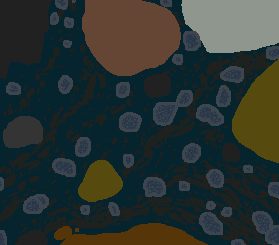14 Sedimini
Name: Sedimini
Ancestor: Membracapsulus and Lipicapsulus
Description: The form of the cell is governed by two separate genomes - one for the phospholipid membrane and some fatty deposits within the cell and membrane, and also responsible for some proteins involved in vacuolisation mechanisms - and the other a much larger genome packaged inside a complex capsule, of which there are many copies throughout the cell, and instruct for most of the cell's functions in cooperation with the smaller membrane genome. The membrane genome has been shortening in function as the larger genome has been assimilating fragments of it gradually over the generations.
They have many different accessory recipies they can use to digest different food sources and metabolise in different environments, so not only does strain and species matter, but so does the environmental resources affecting gene expression. They have proteins which react to temperature, which sets of a chain reaction to produce temperature-appropriate proteins. This gives them a wide rage of temperatures that they can survive in. They are also exposed to more dissolved compounds from the wider ocean, requiring regulation of their interactions with the cell and it's membranes, which comes at the cost of energy and material. In rare cases they may incorporate exotic sea elements and compounds for crudely useful purposes, but in these situations it is of greater importance to lower the concentration of the dissolved substance within the cell by the best achievable form of displacement at the organism's disposal so this function comes first.
Outside of the vents there is a much lower concentration of the gases required for respiration. These cells have become more efficient at their utilization of these resources, but have also adapted to a slower pace of growth and life.
Adrift in cooler water they don't immediately decay. They slow down their metabolic processes, then as their outer membrane sustains damage they prune it by jetisoning it. They are able to slowly shrink their size over time to increase their overall longevity. They are more likely to survive long enough to find a new habitable location to colonise.
Food: Fine volcanic sediment and microbial organic material.
Metabolism: Chemolithotrophic and Chemoorganotrophic
Reproduction: Irregular, spontaneous budding at large cell size, spontaneous division at large cell size
Optimal Ambient Temperature: 75°C (Min: 55°C, Max: 100°C)
Regions: Deep hydrothermal vent
Remove these ads. Join the Worldbuilders Guild









Comments